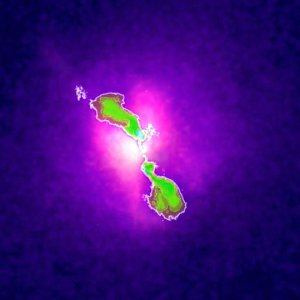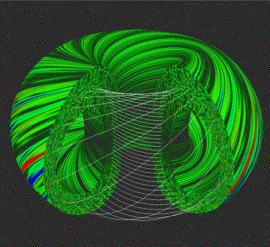Introduction.
Most of the luminous matter in the Universe --- clusters of galaxies,
interstellar medium of the galaxies, protostellar discs, stars --- is
in the form of ionised gas, or plasma, and most of this plasma is in a
turbulent state. The same is true for man-made laboratory plasmas, most
importantly the plasmas of fusion devices. Turbulence is stochastic
fluid motion (and, in the case of plasma turbulence, also stochastic
fluctuations of the electric and magnetic fields)
in a broad range of scales.
This arises because typically the sources of energy in turbulent
systems are at large, often system-size, scales at which instabilities
or stirring occur, while dissipation of this energy into heat happens
at small, microphysical scales (particle mean free path, Larmor radii).
Turbulence is thus a nonlinear transport mechanism. Theory of plasma
turbulence can be viewed as the theory of transport of energy (and also
mass, momentum, heat etc.) in the stochastic cocktail of fluid motions
and electromagnetic fluctuations that makes up both astrophysical and
laboratory plasma objects. That is why understanding turbulence is of
great practical importance: even large-scale properties of plasma
systems cannot be predicted without a working model of turbulent
transport. To give three examples of central questions in fusion
science and astrophysics where no progress is possible without a
working model of plasma turbulence: theory of turbulent (or
“anomalous”)
heat transport in tokamaks that hinders plasma confinement and constitutes a major obstacle to progress towards fusion energy; theory of
accretion onto black holes, which requires a model of turbulent transport of momentum; theory of
magnetogenesis,
or the origin of cosmic magnetic fields, which are most likely to be
due to the dynamo action by turbulence. Besides this applied
importance, the theory of plasma turbulence is a formidable and
fascinating intellectual challenge in its own right --- indeed,
“solving” turbulence has long been the holy grail of
nonlinear physics and the problem of turbulence is sometimes referred
to as the last great problem of classical physics.
Unlike in the case of neutral fluid, even a solid qualitative
understanding of plasma turbulence is currently lacking. We believe
that a fortuitous confluence of circumstances has now created an
opportunity for a major breakthrough: high performance computing is
finally performing at the level of resolution that realistic turbulence
can be simulated, great advances in astronomical instrumentation have
made accessible to observational study a rich world of small-scale
fluctuations (particularly in the solar wind), approval of the ITER
project has breathed renewed enthusiasm (and resources) into fusion
science, and a number of recent theoretical advances have made some of
the key problems appear to be solvable at last.
A turbulent plasma is characterised by a hierarchy of scales that
define separate physical regimes. We shall examine these regimes and
the connections between them. Like in all complex systems, the
interaction of the parts (regimes) is as important as the internal
dynamics of the parts. At large scales (roughly speaking, larger than
the particle mean free path), plasma behaves as a conducting fluid and
can be described by magnetohydrodynamics (MHD). At small scales, plasma
must be treated kinetically, i.e., as a collisionless ensemble of ions
and electrons interacting with the electromagnetic fields. The
collisionless regime breaks into several subregimes depending on
whether ions and electrons must be treated as adiabatic, isothermal or
fully kinetic. Transfer of energy from large to small scales --- both
within the same regime or between different regimes --- can occur
either by means of “local” cascade from scale to scale or
“nonlocally” via formation of structures at the dissipation
scales (examples are shocks, current sheets, various high-frequency
instabilities). In most real plasmas, the dissipation of the turbulent
energy happens at the collisionless scales.
Method.
Turbulent fluctuations in most fusion and astrophysical plasmas are
long-period compared to the time it takes a particle to orbit a
magnetic field line. It is then possible to treat the particles as
rings of charge attached to field lines. The systematic mathematical
description of plasma based on this idea is called
gyrokinetics.
It is ideally suited both for theory and numerical simulations of
plasma turbulence. Gyrokinetic simulations of turbulence and transport
in fusion devices are now a mature field with more then 10 years of
experience and code development --- this Network includes some of
the leading experts in the field. Besides the conventional fluid
simulations, gyrokinetic theory and simulations are the key method
in our research programme (in astrophysics, this breaks new ground
as nothing of the kind has been attempted before). They require
large-scale computational resources, which are mustered by combining
the UK resources with those of the US supercomputing centres.
Key questions.
The two paramount issues in the theory of plasma turbulence are its
transport properties and its ability to generate magnetic fields
(dynamo). Some of the more particular (sub)questions that we are
pursuing are
- What are the types of fluctuations that make up the turbulent
cascades in each of the regimes? What scaling relations are obeyed?
What is the degree of nonlocality and anisotropy of these cascades?
What is the structure of the (gyrokinetic) microturbulence at and below
the ion gyroscale --- the interplay between ion heating, kinetic
Alfvén waves, entropy fluctuations (fine-scale structure in
phase space), drift waves and various instabilities? (This has many
applications in fusion plasmas and in the “dissipation-range” physics of the solar wind.)
- How efficient is the dissipation at various microscales: the mean
free path, the ion and electron gyroscales? How much ion and electron
heating is there? (The latter question is particularly interesting in
the contexts of coronal and solar-wind heating and accretion flows.)
- How does turbulence generate, shape and maintain magnetic fields
in astrophysical plasmas? What is the spatial structure of these
fields? (Applications in galaxy clusters, interstellar medium, the Sun, and liquid-metal dynamo experiments.)
- What is the role of large-scale shear and rotation in generating
magnetic fields and turbulence and in setting the properties of the
saturated state? In particular, what is the nonlinear mechanism of the
magnetorotational instability in accretion discs
and the momentum-transporting properties of the resulting turbulence?
How do collisionless plasma kinetics affect this turbulence? (Sheared
gyrokinetic turbulence is also interesting in the context of rotating fusion plasmas.)
- How do small-scale plasma instabilities excited by pressure
anisotropies change the transport properties of collisionless plasmas?
(Especially in the solar wind and galaxy cluster plasmas.)
Interdisciplinarity. The three main communities represented in the Network are plasma/fusion science, space/astrophysics and fluid dynamics. In
plasma science,
an extensive amount of knowledge exists about the microphysical plasma
processes (waves, instabilities, dissipation) and a large effort has
been invested into creating very advanced computational tools to
simulate turbulence and transport in tokamaks (gyrokinetic codes are
the prime example). However, for a number of technical reasons, the
available experimental data cannot match the extraordinarily detailed
in situ measurements of the turbulence in the
solar wind
--- and, while the physical regimes are, of course, not identical, many
of the properties of the turbulence probably are universal and much is
to be gained in both fields by, for example, using the gyrokinetic
computing power to model solar wind turbulence and doing a detailed
comparison with observations. The same is true for the collaboration
with
radio and X-ray astronomers ---
a great wealth of physical problems and a great wealth of data that
exist there help test plasma physics tools and stimulate plasma
physics experts.
Fluid dynamics
complements this collaboration with the expertise borne of a long
history of thinking about turbulence as a nonlinear problem that should
be diagnosed and solved using statistical methods. Thus, our strategy
and the defining feature of this Network is the encouragement of
synergy between these three fields.

